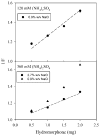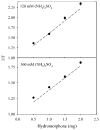A mathematical relationship for hydromorphone loading into liposomes with trans-membrane ammonium sulfate gradients
- PMID: 20014429
- PMCID: PMC4240746
- DOI: 10.1002/jps.22017
A mathematical relationship for hydromorphone loading into liposomes with trans-membrane ammonium sulfate gradients
Abstract
We have studied the loading of the opioid hydromorphone into liposomes using ammonium sulfate gradients. Unlike other drugs loaded with this technique, hydromorphone is freely soluble as the sulfate salt, and, consequently, does not precipitate in the liposomes after loading. We have derived a mathematical relationship that can predict the extent of loading based on the ammonium ion content of the liposomes and the amount of drug added for loading. We have adapted and used the Berthelot indophenol assay to measure the amount of ammonium ions in the liposomes. Plots of the inverse of the fraction of hydromorphone loaded versus the amount of hydromorphone added are linear, and the slope should be the inverse of the amount of ammonium ions present in the liposomes. The inverse of the slopes obtained closely correspond to the amount of ammonium ions in the liposomes measured with the Berthelot indophenol assay. We also show that loading can be less than optimal under conditions where osmotically driven loss of ammonium ions or leakage of drug after loading may occur.
(c) 2009 Wiley-Liss, Inc. and the American Pharmacists Association
Figures








Similar articles
-
Pharmacokinetics of ammonium sulfate gradient loaded liposome-encapsulated oxymorphone and hydromorphone in healthy dogs.Vet Anaesth Analg. 2013 Sep;40(5):537-45. doi: 10.1111/vaa.12042. Epub 2013 Apr 20. Vet Anaesth Analg. 2013. PMID: 23601353 Free PMC article.
-
Transmembrane ammonium sulfate gradients in liposomes produce efficient and stable entrapment of amphipathic weak bases.Biochim Biophys Acta. 1993 Sep 19;1151(2):201-15. doi: 10.1016/0005-2736(93)90105-9. Biochim Biophys Acta. 1993. PMID: 8373796
-
[Influencing factors in preparation of brucine liposomes by ammonium sulfate transmembrane gradients].Zhong Yao Cai. 2008 Sep;31(9):1410-2. Zhong Yao Cai. 2008. PMID: 19180971 Chinese.
-
Active methods of drug loading into liposomes: recent strategies for stable drug entrapment and increased in vivo activity.Expert Opin Drug Deliv. 2011 May;8(5):565-80. doi: 10.1517/17425247.2011.566552. Epub 2011 Apr 15. Expert Opin Drug Deliv. 2011. PMID: 21492058 Review.
-
Quantitative aqueous ammonium ion analysis by transmission infrared spectroscopy.J Assoc Off Anal Chem. 1986 Nov-Dec;69(6):924-8. J Assoc Off Anal Chem. 1986. PMID: 3542955 Review.
Cited by
-
Epidural administration of liposome-encapsulated hydromorphone provides extended analgesia in a rodent model of stifle arthritis.J Am Assoc Lab Anim Sci. 2011 Jul;50(4):507-12. J Am Assoc Lab Anim Sci. 2011. PMID: 21838980 Free PMC article.
-
Physicochemical properties of epidermal growth factor receptor inhibitors and development of a nanoliposomal formulation of gefitinib.J Pharm Sci. 2012 Aug;101(8):2763-76. doi: 10.1002/jps.23180. Epub 2012 May 11. J Pharm Sci. 2012. PMID: 22581704 Free PMC article.
-
Quantitative structure-property relationship modeling of remote liposome loading of drugs.J Control Release. 2012 Jun 10;160(2):147-57. doi: 10.1016/j.jconrel.2011.11.029. Epub 2011 Dec 1. J Control Release. 2012. PMID: 22154932 Free PMC article.
-
CAR, a Homing Peptide, Prolongs Pulmonary Preferential Vasodilation by Increasing Pulmonary Retention and Reducing Systemic Absorption of Liposomal Fasudil.Mol Pharm. 2019 Aug 5;16(8):3414-3429. doi: 10.1021/acs.molpharmaceut.9b00208. Epub 2019 Jun 27. Mol Pharm. 2019. PMID: 31194563 Free PMC article.
-
Sustained Release from Ionic-Gradient Liposomes Significantly Decreases ETIDOCAINE Cytotoxicity.Pharm Res. 2018 Oct 10;35(12):229. doi: 10.1007/s11095-018-2512-4. Pharm Res. 2018. PMID: 30306273
References
-
- Haran G, Cohen R, Bar LK, Barenholz Y. Transmembrane ammonium sulfate gradients in liposomes produce efficient and stable entrapment of ampbipathic weak bases. Biochim Biophys Acta. 1993;1151:201–215. - PubMed
-
- Maurer N, Wong KF, Hope MJ, Cullis PR. Anomalous solubility behavior of the antibiotic ciprofloxacin encapsulated in liposomes: a 1H-NMR study. Biochim Biophys Acta. 1998;1374:9–20. - PubMed
-
- Wong JP, Yang H, Blasetti KL, Schnell G, Conley J, Schofield LN. Liposome delivery of ciprofloxacin against intracellular Francisella tularensis infection. J Control Release. 2003;92:265–273. - PubMed
-
- Grant GJ, Barenholz Y, Bolotin EM, Bansinath M, Turndorf H, Piskoun B, Davidson EM. A novel liposomal bupivacaine formulation to produce ultralong-acting analgesia. Anesthesiology. 2004;101:133–137. - PubMed
Publication types
MeSH terms
Substances
Grants and funding
LinkOut - more resources
Full Text Sources
Other Literature Sources

